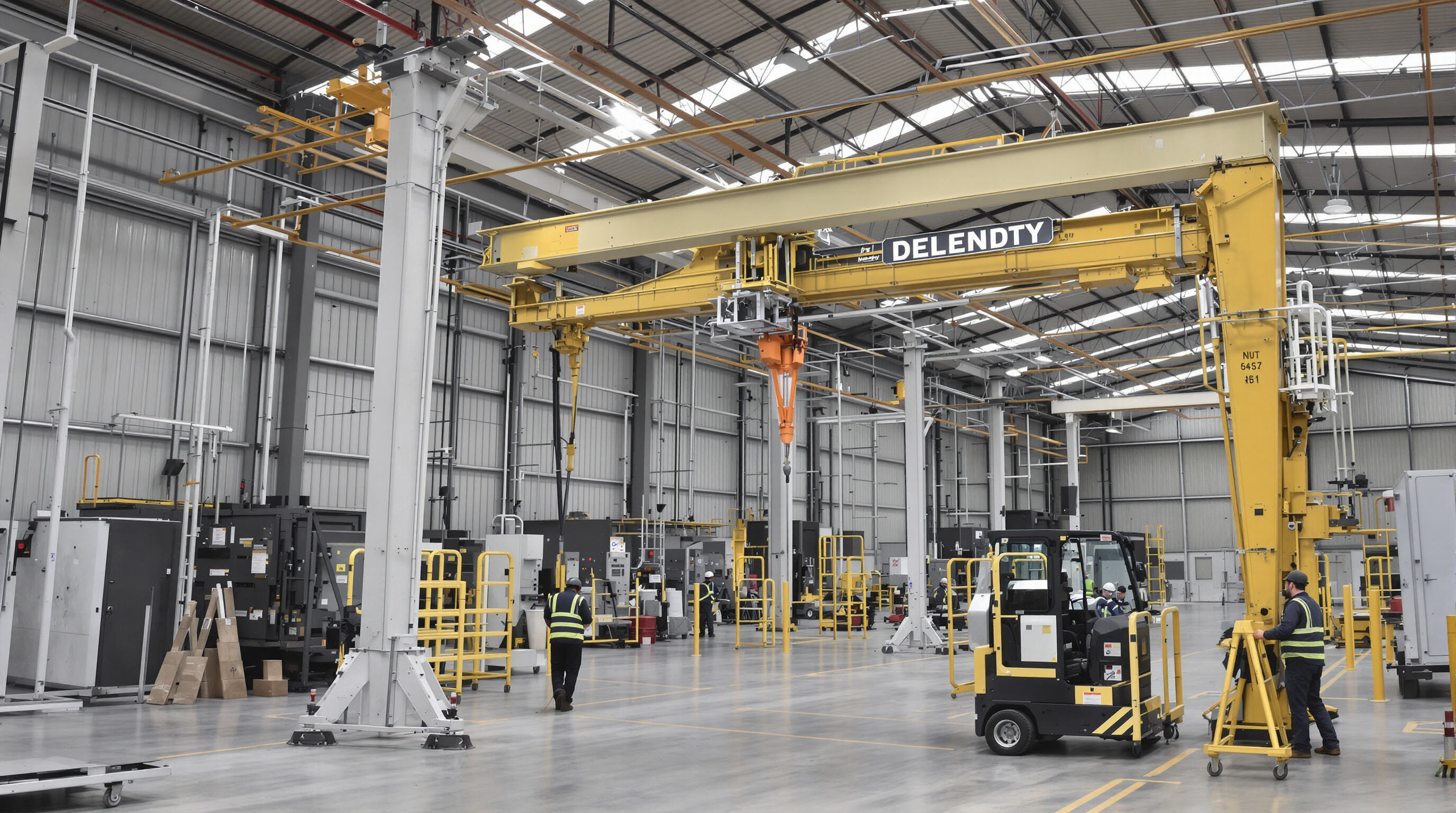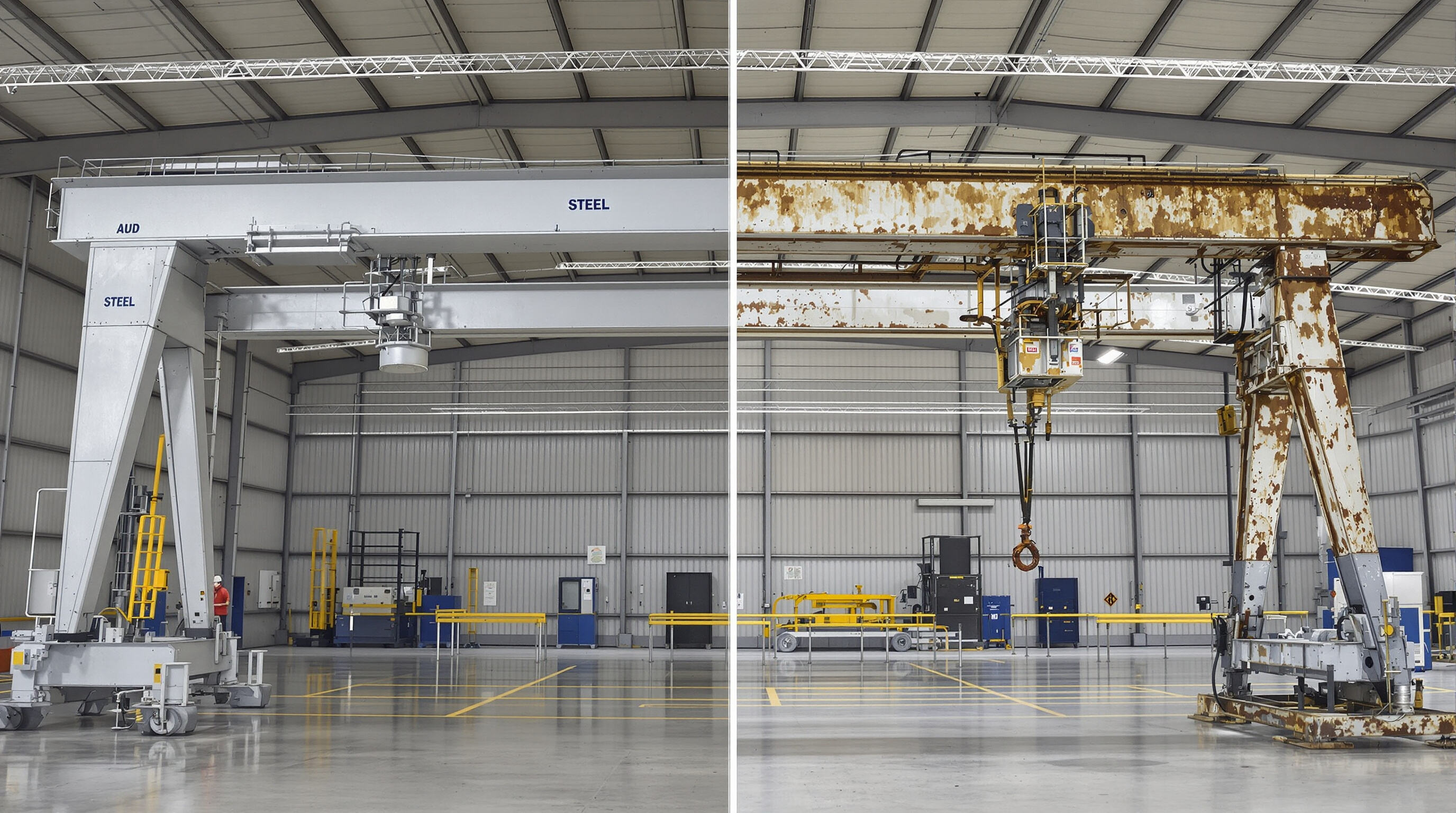왜 알루미늄 갠트리 크레인 현대 물류 취급 방식 혁신

산업 현장에서는 전통적인 강철 모델을 대체하기 위해 알루미늄 갠트리 크레인의 도입이 빠르게 확산되고 있으며, 이는 그 어느 때보다 뛰어난 이동성과 강도를 제공하기 때문입니다. 이러한 전환은 다양한 작업 환경에서 유연한 물류 처리에 대한 수요 증가에 대응하는 것입니다.
산업 분야에서 경량 이동형 리프팅 솔루션으로의 전환
제조 및 물류 산업에서는 알루미늄 갠트리 크레인을 매우 선호하는데, 이는 현장에 빠르게 설치할 수 있기 때문이다. 휴대용 모델은 현장에 고정 설치된 강재 크레인에 비해 약 60% 더 빠르게 이동한다. 오늘날 기업들은 린 생산 방식에 적합하며 여러 작업장에서 활용할 수 있는 장비를 필요로 한다. 일시적인 건설 현장을 예로 들 수 있다. 이곳의 작업자들은 특수 도구 없이도 조립할 수 있는 크레인이 필요하다. 이는 설치 시간을 절약할 수 있다. 이러한 방식이 보편화되기 전에는 설치 대기 시간에 시간당 약 150달러의 비용이 소요되었다고 2024년에 발간된 '산업 효율 저널(Industrial Efficiency Journal)'에 기록되어 있다.
소재의 장점: 알루미늄 합금의 강도 대 중량 비율 및 내식성
알루미늄 합금은 두 가지 공학적 특성을 결합함으로써 뛰어난 성능을 제공한다:
- 강도 대 중량 비율 : 6082-T6과 같은 합금은 강철 제품 대비 무게가 70% 가벼운 동시에 구조적 완전성을 유지한다
- 부식 방지 : 보호 산화층은 습기 또는 화학물질에 노출된 환경에서 손상을 방지하며, 강철보다 우 superior한 성능을 발휘합니다.
: 이러한 특성 덕분에 재료 성능 협의회(Materials Performance Council)의 기준에 따르면, 5년 동안의 유지보수 비용이 강철 대체재 대비 40% 낮습니다. 해양 장비 유지보수 및 화학 처리 시설 분야에서 특히 이러한 장점을 활용하고 있습니다.
: 항공우주, 제조업 및 임시 작업 현장에서 수요 증가
: 다음의 세 분야가 채택을 주도하고 있습니다:
- 항공우주 : 민감한 항공 전자 장비 부품을 취급할 때는 정전기가 발생하지 않는 정밀 장비가 필요합니다.
- 제조업 : 유연한 생산 라인에서는 다양한 제품 조립을 위한 재구성 가능한 스팬(구조)을 활용합니다.
- 구조 : 이동식 개트리(지브 기중기)는 영구적인 인프라 없이도 중량물을 들어올릴 수 있습니다.
: 시장 분석을 통해 2022년 이후 임시 작업 현장에서 알루미늄 크레인 사용이 연간 18% 성장한 것으로 확인되었습니다. 이는 운영 발자국을 줄이면서도 최대 5톤까지 효율적으로 들 수 있는 유연한 자재 취급 솔루션으로 산업 전반의 패러다임이 전환되고 있음을 반영합니다.
휴대성과 유연성을 향상시키는 혁신적인 디자인 기능
협소하거나 동적인 작업 공간에 맞는 모듈식 및 조절 가능한 구성
알루미늄 갠트리 크레인은 모듈식 설계 덕분에 협소한 공간에서의 작업 방식을 바꾸고 있습니다. 이러한 크레인은 필요에 따라 재배치할 수 있는 설계로, 조절 가능한 높이의 빔과 신축식 다리를 갖추고 있어 비행기 격납고부터 일반 장비가 작동하기 어려운 복잡한 환경인 바쁜 공장 층까지 다양한 공간에 적응할 수 있습니다. 실제로 이러한 크레인의 가장 큰 장점은 생산 라인의 다른 작업을 중단시키지 않고도 라인 내 여러 구역 사이를 쉽게 이동할 수 있다는 점입니다. 빠르게 변화하는 요구사항에 대응해야 하는 제조업체에게 이러한 유연성은 짧은 시간 내 새로운 조건에 적응하면서 생산성을 유지하는 데 큰 차이를 만듭니다.
휴대용 구성 요소: 바퀴, 접이식 프레임, 도구가 필요 없는 조립 방식
이러한 크레인은 무거운 하중을 견딜 수 있는 캐스터가 장착되어 있어 부드럽게 이동이 가능하며, 사용하지 않을 때는 접을 수 있는 붐과 직관적인 연결 시스템을 갖추고 있습니다. 작업자는 약 15분 만에 1톤을 들어올 수 있는 기능을 갖춘 완전한 크레인을 설치할 수 있으며, 도구 없이도 분해하여 운반할 수 있습니다. 작업 모드와 운송 모드를 자유자재로 전환할 수 있는 이러한 기능은 매일 장비를 옮겨야 하는 건설 현장이나 주중 여러 장소에서 유지보수를 수행해야 하는 작업반에게 매우 유용합니다. 더 이상 번거로운 설치 작업이나 오랜 대기 시간으로 인해 어려움을 겪을 필요가 없습니다.
경량 구조의 강도 기술: 알루미늄 합금이 중량 있는 하중을 어떻게 지탱하는가
고품질 알루미늄 합금은 가벼운 무게에 비해 뛰어난 강도를 제공하며, 일부 시험에서는 항복 강도가 275MPa 이상인 것으로 나타났습니다. 강철과 비교할 때 6000 시리즈는 부피 대비 약 3분의 2 정도 가볍지만 형태와 강도를 그대로 유지합니다. 이는 불필요한 중량 증가 없이 무거운 하중을 들어올려야 하는 크레인 시스템에 매우 유리합니다. 모듈식 섹션 하나의 무게는 약 42kg에 불과하지만 최대 4톤까지 지탱할 수 있습니다. 이 비결은 압력을 고르게 분산시키는 정교하게 설계된 I-빔과 트러스 구조에 있습니다. 또한 특수 코팅 처리로 인해 유출된 오일이나 야외의 혹독한 기상 조건에서도 부식과 마모에 강합니다.
주요 산업 분야 응용 알루미늄 갠트리 크레인
제조업: 유연한 어셈블리 라인 및 린 운영 구현
알루미늄 갠트리 크레인은 5톤 정도의 중간 하중을 처리할 수 있을 뿐만 아니라 설치에 많은 준비가 필요하지 않기 때문에 제조업체가 작업을 보다 빠르게 수행할 수 있도록 도와줍니다. 이러한 크레인 자체의 무게가 그리 무겁지 않기 때문에 작업자들이 공장 내에서 한 장소에서 다른 장소로 쉽게 이동시킬 수 있습니다. 이는 다양한 제품 간 전환 시 대기 시간이 줄어든다는 것을 의미합니다. 지난해 물자 취급 분야에서 발표된 일부 연구에 따르면, 구식 철강 기반 시스템과 비교해 알루미늄 크레인으로 전환한 공장들은 자동차 부품 조립 작업에서 생산 사이클이 약 18% 증가한 것으로 나타났습니다. 또한 알루미늄은 다른 금속들처럼 부식되거나 녹슬지 않기 때문에 식품 가공업체와 화학 제품 제조업체에서 특히 선호합니다. 이러한 환경에서는 청결성이 매우 중요하며, 장비가 오래 사용하더라도 품질이 저하되지 않기 때문에 경영 측면에서도 합리적인 선택이 됩니다.
건설: 영구 설치 없이 현장에서 효율적인 리프팅 작업
이러한 신형 크레인 모델은 콘크리트 거푸집 설치나 현장의 철골 보 정렬 시 필요했던 비용이 높은 기초 공사 없이도 이동이 간편하고 신속하게 설치할 수 있는 구조로 설계되어 있습니다. 많은 계약자들이 표준 타워 크레인 대신 사용함으로써 단기 리프팅 작업에서 약 30% 정도 절감 효과를 얻고 있습니다. 특히 좁은 도심 지역에서 유용한 이유는 접이식 프레임과 조절 가능한 스팬 길이 덕분입니다. 공간이 매우 협소한 조건에서도 훌륭한 성능을 발휘하면서도 윗부분에 가해지는 하중 용량과 관련된 OSHA 규정을 충족합니다. 콤팩트한 설계임에도 불구하고 안전성은 여전히 최우선 과제입니다.
항공우주: 정밀 및 민감 부품의 안전한 취급
비행기 제조사들은 엔진 부품을 설치하고 작업장 내 복합 소재를 이동할 때 알루미늄 크레인을 의존합니다. 이러한 표면에 생긴 작은 긁힘자국조차 항공기의 안전 기준 충족 여부에 영향을 줄 수 있습니다. 이러한 크레인은 스파크가 발생하지 않는 특수 합금으로 제작되는데, 이는 많은 격납고에서 추가 예방 조치가 필요한 연료를 다루기 때문에 중요합니다. 일부 업계 보고서에 따르면 위성 제작 과정에서 구형 수동 리프팅 방식을 알루미늄 시스템으로 교체한 후 기업의 불합격률이 거의 절반으로 감소했다고 합니다. 실제로 더 나은 장비는 실수와 폐기 부품을 줄여 줍니다.
물류 및 창고 관리: 적재, 하역 및 저장 최적화
알루미늄 모듈식 갠트리는 자동화 창고와 함께 사용할 때 매우 효과적이며, 요즘 많은 기업들이 도입하고 있는 정확한 재고 관리 방식을 지원하는 데 도움이 됩니다. 창고 작업자들은 다양한 크기의 컨테이너에 맞춰 높이 조절을 도구 없이 할 수 있게 되면서 팔레트 적재 속도가 약 25% 향상되었다고 보고하고 있습니다. 이러한 알루미늄 시스템은 기존의 강철 제품 대비 약 65% 가벼워 작업자들이 직접 로딩 구역 주변으로 이동시킬 수 있어 지게차를 부르는 수고를 덜 수 있습니다. 바로 이러한 유연성 때문에 최근 몇 년간 다양한 제3자 물류 센터에서 이 기술을 도입하게 된 것입니다.
강철 갠트리 크레인에 비한 성능 및 유지보수 혜택

무게, 적재 용량 및 내구성: 알루미늄 대 강철 대결
알루미늄 갠트리 크레인은 강철로 제작된 크레인에 비해 강도 대비 무게 비율이 훨씬 우수하며, 일반적으로 무게가 40~50% 가량 더 가볍습니다. 매우 가볍지만 강도가 높기 때문에 이러한 크레인은 실제로 5톤 이상의 화물을 들어올릴 수 있습니다. 대부분의 하중을 지탱하는 핵심 부품들은 항공기 제작에 사용되는 소재와 유사한 특수 합금으로 만들어졌습니다. 이러한 소재는 금속 피로에 대한 저항성이 뛰어나기 때문에 수천 번의 작동 후에도 크레인 구조가 안정적으로 유지됩니다. 또 하나의 큰 장점은 알루미늄은 강철과 달리 충격을 받아도 쉽게 휘지 않는다는 점입니다. 따라서 극한의 추위인 영하 20도에서부터 무더운 환경인 섭씨 50도까지, 크레인은 작업 환경이 변하더라도 처음의 치수를 안정적으로 유지합니다.
부식 저항성으로 인한 유지보수 필요성 감소
알루미늄은 천연적으로 산화층을 형성하여 습기나 강한 화학물질에 노출되더라도 녹이 생기지 않도록 방지합니다. 유지보수 비용 측면에서 알루미늄은 10년 동안 강철 제품 대비 약 60%의 비용을 절약할 수 있습니다. 강철 제품은 지속적인 코팅 보호가 필요합니다. 염수 환경에서는 강철이 연간 약 1.6mm의 부식 속도를 보이는 반면, 알루미늄은 연간 단 0.03mm로 거의 마모가 발생하지 않습니다. 이는 알루미늄 게antry 크레인이 기존의 강철 제품이 고비용의 갈바닉 절연 시스템을 필요로 하는 해안 지역 작업에 특히 적합함을 의미합니다. 실제 현장 경험에 따르면 표면 처리 및 정기 점검 빈도가 줄어들기 때문에 연간 유지보수 작업 시간을 15~30시간 정도 줄일 수 있습니다.
오해 바로잡기: 알루미늄 모델의 실제 강도와 안전성
새로운 6000 시리즈 알루미늄 합금은 강도 면에서 A36 강철과 견줄 만한 성능을 보이며 약 250MPa 수준에 도달하지만 강철의 무게의 단지 3분의 2 미만에 불과합니다. ASME B30.2 규정에 따라 수행된 테스트 결과에 따르면 이러한 알루미늄 프레임 크레인들은 매우 인상적인 하중을 견뎌낼 수 있는 것으로 나타났습니다. 과부하가 150%에 달하는 상황에서도 휨이나 변형 없이 견고함을 유지했습니다. 안전성 또한 큰 장점으로, 이 설계는 ISO 4301이 요구하는 기준을 넘어섭니다. 이 시스템은 여러 개의 백업 잠금 장치를 포함하고 있으며 약점이 될 수 있는 부분 없이 정밀하게 용접되어 있습니다. 특히 정유소나 화학 공장과 같이 충격이나 이동 과정에서 발생하는 스파크가 심각한 문제를 일으킬 수 있는 작업 환경에서 알루미늄은 거의 언급되지 않는 내재적 이점을 가지고 있습니다. 바로 가연성 물질을 다룰 때 스파크가 발생하지 않는다는 점입니다.
확장 가능한 알루미늄 갠트리 시스템을 통한 커스터마이징 및 미래 대비
현대의 작업 공간은 운영 요구에 맞춰 발전하는 장비를 필요로 합니다. 알루미늄 갠트리 크레인은 모듈식 엔지니어링과 미래 지향적인 설계 원리를 통해 뛰어난 적응성을 제공합니다.
특정 하중 요구 사항 및 환경 조건에 맞게 조정
알루미늄의 강도 대 중량 비율은 제조업체가 구조적 안정성을 희생하지 않으면서도 자신들의 크레인을 맞춤 제작할 수 있게 해줍니다. 민감한 항공 우주 부품을 다루는 작업장의 경우, 보통 5톤 이하의 무게를 다루기 때문에 정확도를 위해 특수하게 설계된 빔이 필요합니다. 한편, 더 큰 산업용 부품을 다루는 창고에서는 때로 10톤까지 가는 무게를 처리하기 때문에 일반적으로 더 강한 합금 프레임을 선택합니다. 알루미늄이 특히 두드러지는 점은 부식에 대한 저항성입니다. 이는 이러한 크레인이 습한 공장 바닥이나 날씨 조건이 열악한 야외 공사 현장에서도 신뢰성 있게 작동할 수 있음을 의미합니다. 일부 모델은 염수 환경에서도 사용할 수 있도록 설계되어 매년 약 1,000시간의 노출에도 녹슬지 않고 오래 사용할 수 있습니다.
다기능 시설 활용을 위한 높이 및 스팬 조절 기능
신축 컬럼 및 조절식 크로스빔을 포함한 모듈식 구성 요소로 제작된 시스템은 작업자에 의해 약 30분 이내에 완전히 재설정할 수 있습니다. 아침 일찍 비행기 조립을 위한 12미터 규모로 시작된 작업 공간이 하루가 지나 오후에는 전자제품 패키지 같은 소형 물품을 다루는 6미터 너비의 공간으로 쉽게 변경될 수 있다고 생각해 보세요. 이러한 변경 작업 시 도구가 필요하지 않기 때문에 소요 시간을 줄일 수 있습니다. 게다가 고정식 바퀴는 정밀 작업이 필요한 상황에서도 모든 장비가 안정적으로 작동할 수 있도록 도와줍니다.
호이스트, 자동화 및 스마트 리프팅 기술과의 통합
업계 리더들은 IoT 센서와 RFID 추적 기술을 알루미늄 갠트리 부품에 직접 내장하여 실시간 하중 모니터링 및 예지 정비 알림 기능을 구현하고 있습니다. 최근 혁신 사례는 다음과 같습니다.
- 무선 제어 장치가 AGV(무인 유도 운반차)와 연동된 크레인 동작을 동기화
- 민감한 물류 작업을 위한 ±0.5% 정확도를 제공하는 로드셀
- 제동 에너지를 보조 전력으로 재활용하는 에너지 회수 시스템
이러한 기술 발전으로 인해 알루미늄 갠트리 크레인은 유연성과 데이터 통합이 운영 효율성을 주도하는 스마트 팩토리 혁명의 핵심 장비로 자리매김하고 있습니다.
자주 묻는 질문
사용하는 주요 장점은 무엇인가요? 알루미늄 갠트리 크레인 강재 크레인 대비?
알루미늄 갠트리 크레인은 경량이며 부식 저항성이 뛰어나 유지보수 비용을 절감합니다. 또한 휴대성이 뛰어나 도구 없이도 빠르게 설치할 수 있습니다.
어떻게 되세요? 알루미늄 갠트리 크레인 중량물을 견딜 수 있나요?
고품질 알루미늄 합금은 강도는 높이면서도 경량의 구조를 제공하여 덧댐 없이 들어올리는 힘을 최적화하며, 전략적으로 설계된 빔 및 트러스 구조로 뒷받침됩니다.
어떤 산업 분야에서 사용되나요? 알루미늄 갠트리 크레인 가장 일반적으로 사용되는 분야는 무엇입니까?
항공우주, 제조, 건설, 물류 및 창고 분야에서 알루미늄 갠트리 크레인을 광범위하게 사용하는데, 이는 유연성, 내구성, 적응성이 뛰어나기 때문입니다.
는 알루미늄 갠트리 크레인 사용이 안전한가요?
네, 다중 잠금 시스템과 스파크가 발생하지 않는 작동 기능을 갖추고 있으며 표준 요구사항을 넘어선 안전성을 확보하기 위해 정밀하게 제작되었습니다.
캔 알루미늄 갠트리 크레인 을(를) 맞춤형으로 제작할 수 있습니까?
물론입니다. 모듈식 설계로 스팬과 높이 조절이 가능하며, 특정 하중 요구사항과 환경 조건에 따라 적응할 수 있습니다.

